Sri Yantra
Prepare to expand the way you look at your world. As the ancient Hindu scriptures stated: Nada Brahma, the world is Sound!
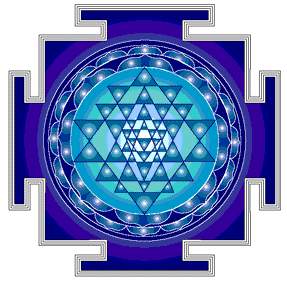
Cymatics,
the study of wave phenomena, is a science pioneered by Swiss medical doctor and natural scientist, Hans Jenny(1904-1972). For 14 years he conducted experiments animating inert powders, pastes, and liquids into life-like, flowing forms, which mirrored patterns found throughout nature, art and architecture. What's more, all of these patterns were created using simple sine wave vibrations (pure tones) within the audible range. So what you see is a physical representation of vibration, or how sound manifests into form through the medium of various materials.Watch the Video
Dr. Jenny's methodology was meticulous, well documented, and totally repeatable. His fascinating body of work offers profound insights into both the physical sciences and esoteric philosophies. It illustrates the very principles which inspired the ancient Greek philosophers Heraclitus, Pythagoras and Plato, on down to Giordano Bruno and Johannes Kepler, the fathers of modern astronomy. "In the beginning was the word..." takes on a whole new meaning while looking at these experiments!
These cymatic images are truly awe-inspiring, not only for their visual beauty in portraying the inherent responsiveness of matter to sound, but also because they inspire a deep recognition that we, too, are part and parcel of this same complex and intricate vibrational matrix.
Joseph's Discussion of the Sriyantra
A hymn from Atharavaveda is dedicated to an object that closely resembles this. The sriyantra ('great object') belongs to a class of devices used in meditation, mainly by those belonging to the Hindu tantric tradition. The diagram consists of nine interwoven isosceles triangles four point upwards, representing Sakti, the primordial female essence of dynamic energy, and five point downwards, representing Siva, the primordial male essence of static wisdom The triangles are ananged in such a way that they produce 43 subsidiary triangles, at the centre of the smallest of which there is a big dot (known as the bindu). These smaller triangles are supposed to form the abodes of different gods, whose names are sometimes entered in their respective places. In common with many depictions of the sriyantra, the one shown here has outer rings consisting of an eight-petalled lotus, enclosed by a sixteen petalled lotus, girdled in turn by three circles, all enclosed in a square with four doors, one on each side. The square represents the boundaries within which the deities reside, protected from the chaos and disorder of the outside world.
Tantric tradition suggests that there are two ways of using the sriyantra for meditation. In the 'outward approach', one begins by contemplating the bindu and proceeds outwards by stages to take in the smallest triangle in which it is enclosed, then the next two triangles, and so on, slowly expanding outwards through a sequence of shapes to the outer shapes in which the whole object is contained. This outward contemplation is associated with an evolutionary view of the development of the universe where, starting with primordial matter represented by the dot, the meditator concentrates on increasingly complex organisms, as indicated by increasingly complex shapes, until reaching the very boundaries of the universe from where escape is possible only through one of the four doors into chaos. The 'inward' approach to meditation, which starts from a circle and then moves inwards, is known in tantric literature as the process of destruction.
The mathematical interest in the sriyantra lies in the construction of the central nine triangles, which is a more difficult problem than might first appear. A line here may have three, four, five or six intersections with other lines. The problem is to construct a sriyantra in which all the intersections are correct and the vertices of the largest triangles fall on the circumference of the enclosing circle. We shall not go into the details of how the Indians may have achieved accurate constructions of increasingly complex versions of the sriyantra, including spherical ones with spherical triangles. Bolton and Macleod (1977) offer a simple overview of the subject; Kulaichev (1984) goes into the 'higher' mathematics implicit in constructing different types of sriyantra.
There is, however, a curious fact about all the correctly constructed sriyantras, whether enclosed in circles or in squares. In all such cases the base angle of the largest triangles is about 51°. The monument that comes to mind when this angle is mentioned is the Great Pyramid at Gizeh in Egypt, built around 2600 BC. It is without doubt the most massive building ever to have been erected, having at least twice the volume and thirty times the mass of the Empire State Building in New York, and built from individual stones weighing up to 70 tonnes each. The slope of the face to the base (or the angle of inclination) of the Great Pyramid is 51°50'35.
It is possible from the dimensions of the Great Pyramid to derive probably the two most famous inational numbers in mathematics. One is pi, and the other is phi the ' golden ratio' or 'divine proportion', given by (1 + sqr-rt 5)/2 (its value to five decimal places is 1.61803). The golden ratio has figured prominently in the history of mathematics, both as a semi-mystical quantity (Kepler suggested that it should be named the 'divine proportion') and for its practical applications in art and architecture, including the Parthenon at Athens and a number of other buildings of Classical Greece. In the Great Pyramid, the golden ratio is represented by the ratio of the length of the face (the slope height), inclined at an angle theta to the ground, to half the length of the side of the square base, equivalent to the secant of the angle theta. The original dimensions of the Great Pyramid are not known exactly, because later generations removed the outer limestone casing for building material, but as far as we can tell the above two lengths were about 186.4 and 115.2 meters respectively. The ratio of these lengths is, to five decimal places, l.618 06, in very close agreement with phi. The number phi has some remarkable mathematical properties. Its square is equal to itself plus one, while its reciprocal is itself minus one. But the most intriguing feature is its link with what are called the Fibonacci numbers.
The Fibonacci numbers are the sequence
0, 1, 1, 2, 3, 5, 8, 13, 21, 34, 55, 89, 144, 233, 377, 610, ...
where each number equals the sum of its two predecessors. This sequence open up in a variety of natural phenomena - in patterns of plant growth and in the laws of Mendelian heredity, for example. It is easily shown that the ratio between successive Fibonacci numbers gets closer to phi the further up the sequence one goes. In the Fibonacci sequence given above, the ratio of 233 to 144 gives the value of phi calculated from the dimensions of the Great Pyramid.
The quantity pi can also be found in the dimensions of the Great Pyramid. If its height (1466 meters) is taken to be the radius of a circle, the perimeter of its base (4 x 230.4 = 921.6 meters) is almost equal to the circumference of that circle (2pir = 921.6 meters). The product of pi and the square root of phi is close to 4.
The largest isosceles triangle of the sriyantra design is one of the face triangles of the Great Pyramid in miniature, showing almost exactly the same relationship between pi and phi as in its larger counterpart. It would be idle to indulge in any further speculation.
Many of the accurate constructions of sriyantras in India are very old. Some are even more complicated than the one shown. There are those that consist of spherical triangles for which the constructor, to adlieve perfect intersections and vertices falling on the circumference of the circle enclosing the triangles, would require knowledge of 'higher mathematics whidh the medieval and ancient Indian mathematicians did not possess' (Kulaichev, 1984, p. 292). Kulaichev goes on to suggest that the achievement of such geometrical constructs in Indian mathematics may indicate 'the existence of unknown cultural and historical alternatives to mathematical knowledge, e.g. the highly developed tradition of special imagination'.
The Vedic seers speak of the Supernal Ether as the house of the supreme immortal Light; and the Tantric adepts speak of the great causal as the permanent place of light. From this mass of infinite light which has no form, emerge during the course of manifestation the rays which fashion the objects of the world as well as the gods in the cosmos, the devas, powers of light.
In manifestation, the limitless One has to limit himself in a form. The formless Great Radiance has to radiate rays of definite forms and marshall them as the various gods thus creating out the One, the Many with distinct and distinguishable forms and features. These lines of light build the form-patterns of the gods, which are known as Yantras or Chakras.
-Anonymus
A note from Kulaichev (Describing an iterative method of Sri Yantra construction outlined in his paper)
Let us look into the general analytical aspect of the polygon. With the help of linear and circular equations and a sequence of super position (of co-ordinates) of the matching line points each structural component may be described by algebraic equation.
The application of iterative methods for finding of appropriate values of all roots requires the knowledge of boungs of its localisation. This is solved only for the polynomial of a single variable. By applying the process of consecutive exclusion may theoretically lead to a polynomially of not higher the 12544 power of a single variable. However, the volume of required analytical transformations is boundless even for high-powercomputers. Thus for first step of transformation (from four required ones) computer must perform more than 10^11 operations, and a volume of calculations on each succeeded step, at least, in 100 times more than preceeding one. Morever, the investigation of such resulting equation requires to operate with a number representation of 4 thousand figures. These demands very far exceed the capacities of modern computers.
Bolton and Macleod discuss Sri Yantra
The term yantra, which literally means an instrument for holding or restraining, may be used to denote a variety of linear diagrams which play a significant role in the meditative practices of Tantric Hinduism. Yantras may be simple designs such as the cross, triangle, square, circle or lotus pattern, symbolizing basic concepts, or may be more complex combinations of such elements in figures representing in abstract form the particular creative forces in the cosmos which are called divinities. they are closely related to the mandalas used by both Hindu and Buddhist Tantrism, in which geometric design is supplemented by elaborate symbolic images of the deities which by their various forms and attributes indicate different aspects of the hidden order of reality. As Mircea Eliade says (1), the yantra is 'the linear paradigm of the mandala', expressing the same principles in geometric form. Like mandalas, yantras are used in the context of meditation and worship as visual-aids to concentration of the mind leading to realization of abstract principle which is the inner meaning of the visible representation.
The best known and geometrically the most complex yantra is the Sri-yantra, also known as the Sri-yantra, employed by the Sakta school of Tantrism which visualizes the divine primarily in female form. The structure of this yantra is enigmatically described in the Saundarya-lahari (The Wave of Beauty) (2), a lengthy poem praising the great goddess whose dwelling place the Sri-yantra is said to be.
By reason of the four Srikanthas (srikantha is an epithet of Siva) and the five damsels of Siva (which have the nature of Sakti), which are penetrated by Sambhu (i.e. bindu- the dot in the centre) and constitute the nine fundamental natures, the 43 (or 44) angles of your dwelling place are evolved, along with the 8-petalled and 16-petalled lotuses, the circles and the three lines. (stanza 11)
The diagram may be more accurately described as a bilaterally symmetrical figure composed of nine interwoven isosceles triangles, usually depicted with five triangles pointing downwards and four pointing upwards. The former are said to correspond to the yoni representing the dynamic female principle of energy (Sakti), while the latter correspond to the linga representing the static male principle of wisdom (Siva). (The Buddhist Tantrics, incidentally, regard the male principle as dynamic and the female as static.) The central dot called bindu represents the original unity of the male and female principles prior to creation and the paradoxical point female principles prior to creation and the paradoxical point from which the manifestation of the cosmos emerges. The interpenetration of the nine basic triangles gives rise to a number of subsidiary triangles (43 including the central triangle enclosing the bindu) which form the abodes of the deities, representing the particularization of the original creative forces into more concrete manifestations. Sometimes the names of deities and Sanskrit syllables are written into these triangles, or images of the deities are placed in them.
In most versions of the yantra this central design is enclosed by two circular lotus-patterns with eight and sixteen petals, a girdle of three concentric circles, and finally a square arrangement of straight line ('the three lines') with four openings or 'doors' at the cardinal points called 'World House' (bhugra). This square outline, which is common also to mandalas, symbolizes the royal palace in which the deities reside - an area of sacred space protected from the disintegrating forces of chaos. In general, the Sri-yantra is a 'cosmogram' - a graphic representation of the universal processes of emanation and reabsorption reduced to their essential outline. As Eliade puts it, the yantra: 'An expression in terms of linear symbolism of the cosmic manifestations, beginning with the primordial unity.
after completing this procedure, chant below mentioned slok.
Chant below mentioned slok for 1,25,000 or at least 12,500 times.
| No. | Name of the Chakra | Description | The Mudras | The Yoginis | The Presiding Deity | The Mantra |
|---|---|---|---|---|---|---|
| 1 | Trailokya Mohana | Square of three lines with four portals | Sarva Sankshobhini | Prakata | Tripura | Am Aam Saumh |
| 2 | Sarvasa Paripuraka | Sixteen petals | Sarva Vidrawini | Gupta | Tripuresi | Aim Klim Saumh |
| 3 | Sarva Sankshobhana | Eight petals | Sarvakarshini | Guptatara | Tripurasundari | Hrim Klim Saumh |
| 4 | Sarva Saubhagyadayaka | Fourteen cornered figure | Sarvavasankari | Sampradaya | Tripuravasini | Haim Hklim hsaumh |
| 5 | Sarvarthasadhaka | Ten edged figure | Sarvonmadini | Kulottirna | Tripurasri | Hsaim Hsklim hssaumh |
| 6 | Sarva Rakshakara | Ten edged figure | Sarva mahankusa | Nigarbha | Tripuramalini | Hrim Klim Blem |
| 7 | Sarva Rogahara | Eight edged figure | Khechari | Rahasya | Tripurasiddha | Hrim Shrim Saumh |
| 8 | Sarva Siddhi Prada | Triangle | Bija | Atirahasya | Tripurambika | Hsraim Hsklim Hsstramh |
| 9 | Sarvanandamaya | Point | Yoni | Parapara Rahasya | Mahatripurasundari | Panchadashi (Shodashi va) |
The Mantra of Sri Yantra
| Mantra | Bija | Meaning |
|---|---|---|
| AUM | There is no translation of AUM. It consists of three letters: A, U, and M. It signifies the three periods of time, the three states of consciousness and all of existence. A is the waking state, U is the dreaming state and the M is the deep sleep state. AUM contains nada and bindu. Nada is the prolonged vowel sound and bindu is the humming sound, made with closed lips, with which the Mantra ends. | |
| Kshasraum | Narasimha bija. Removes all fear and sorrows. Ksha is Narasimha, ra is Brahma, au means with teeth pointing upwards, and bindu means dispeller of sorrow. | |
| Aim | This is Saraswati Bija. This enables young people to be proficient in all branches of learning. This is the Mantra of Saraswati. Ai stands for Saraswati, and bindu is the dispeller of sorrow. | |
| Shreem | This is a mantra of Lakshmi. Repetition of this leads one to prosperity and contentment. Ra means wealth. Ee is satisfaction or contentment. Nada is the manifested Brahman, and bindu means the dispeller of sorrow. | |
| HOOM | In this Mantra Ha is Siva and u is Bairava. Nada is the Supreme and bindu means dispeller of sorrow. | |
| HAUM | In this Mantra, Ha is Siva and au is Sadasiva. The nada and bindu mean that which dispels sorrow. With this Mantra, Lord Siva should be worshipped. | |
| Hreem | This is Bhuvaneshavri Mantra. It is also called Maya bija. Its importance is described in Devi Bhagavatma. One becomes a leader of people and gets all one needs. Ha means Siva, ra is prakriti, ee means Mahamaya. Nada is the Mother of the universe and bindu is the dispeller of sorrow. | |
| Kleem | This is the famous Kamraj Beej. It fulfills one's desires. This is the Kamabija. Ka means Kamadeva, the lord of desire: it also means Lord Krishna. La means Indra, the ruler of Heaven, also lord of the senses. Ee means contentment or satisfaction. Nada and bindu mean those that bring happiness and sorrow. | |
| Kreem | With this Mantra Kalika should be worshipped. Ka is Kali, ra is Brahman and ee is Mahamaya. Nada is the Mother of the universe and bindu is the dispeller of sorrow. | |
| Dum | This is Durga Beej. Here Da means Durga and u means to protect. Nada means Mother of the universe and bindu signifies action (worship or prayer). This is the bija Mantra of Durga. | |
| Gam | This is the Ganesha bija. Ga means Ganesha and bindu is the dispeller of sorrow. | |
| GLAUM | These are the Beej of Ganesh. Removes all obstacles and promotes success. Ga means Ganesha, la means that which pervades, au means luster or brilliance, and bindu is the dispeller of sorrow. | |
| Lam | This is the Prithvi (Earth) beeja. It helps to secure good crops. | |
| Yam | This is a Vayu (air) beeja and is supposed to help secure rains. | |
| Aam | Brahma | |
| Um | Vishnu | |
| Ram | Rudra |
-
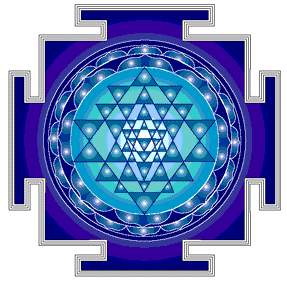
The Most auspicious and result giving also, is the source of attaining all worldly desires and living wants, it can give you wealth and prosperity. Beej mantra ::: Aum Srim Hrim Klim Hrim Shree Mahalaxmai Namah.
-
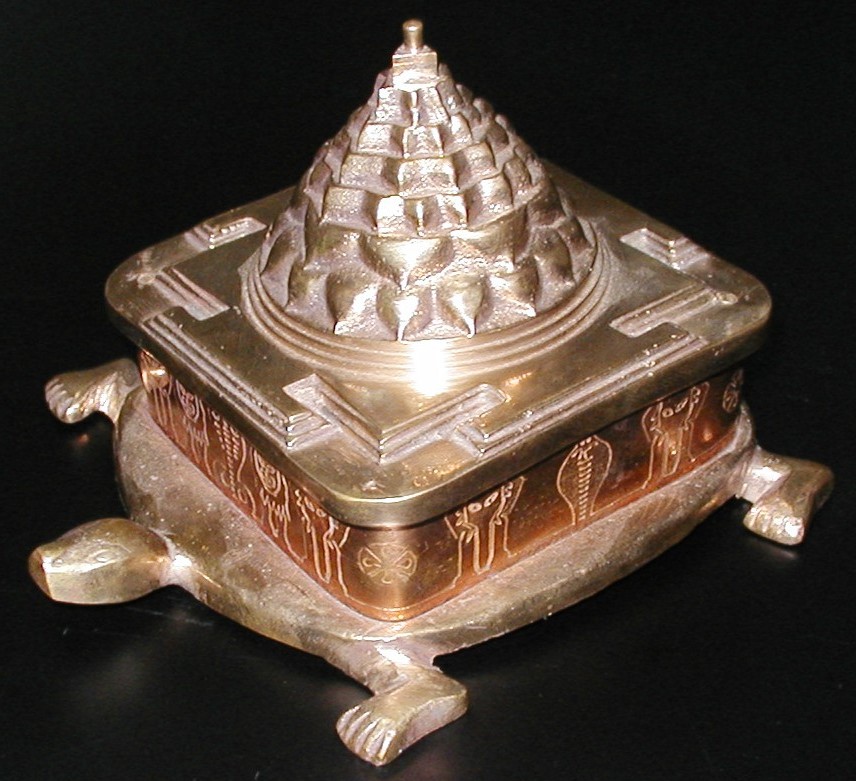
Aum Shrim Hrim Klim Hrim Shree Mahalaxmai Namah. Sriyantra is on the top of tortoise. Tortoise is the most auspicious form, it brings all sorts of prosperity.
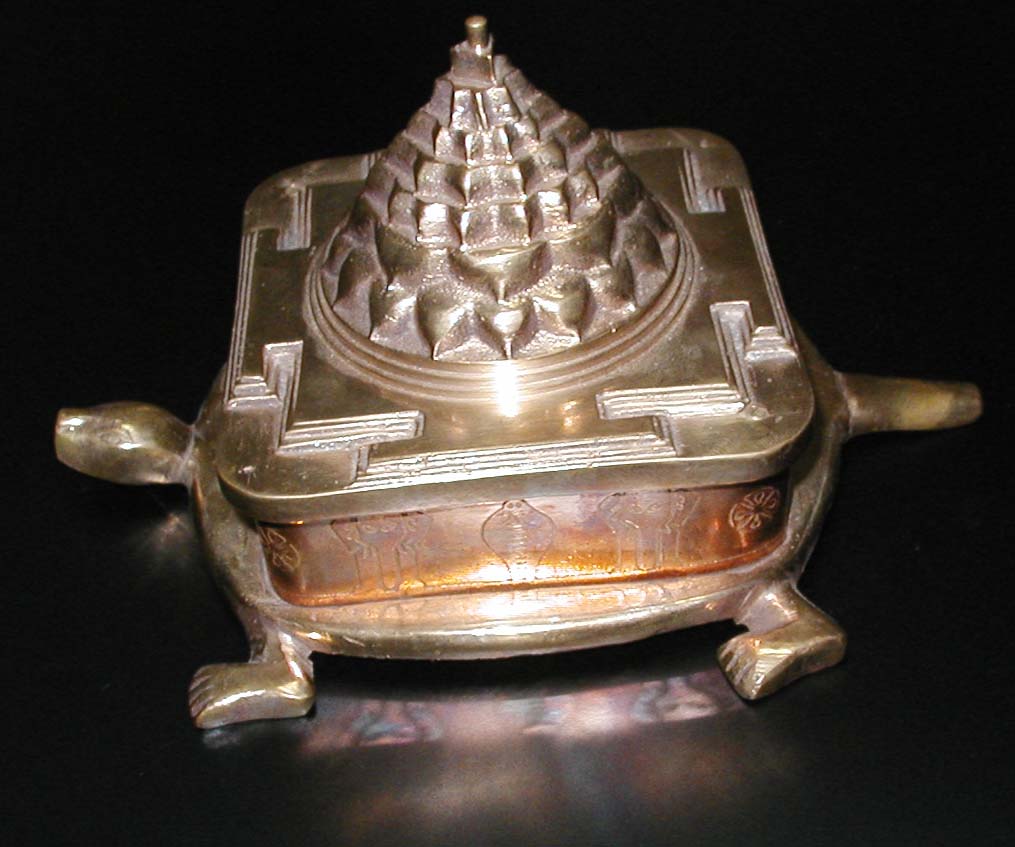
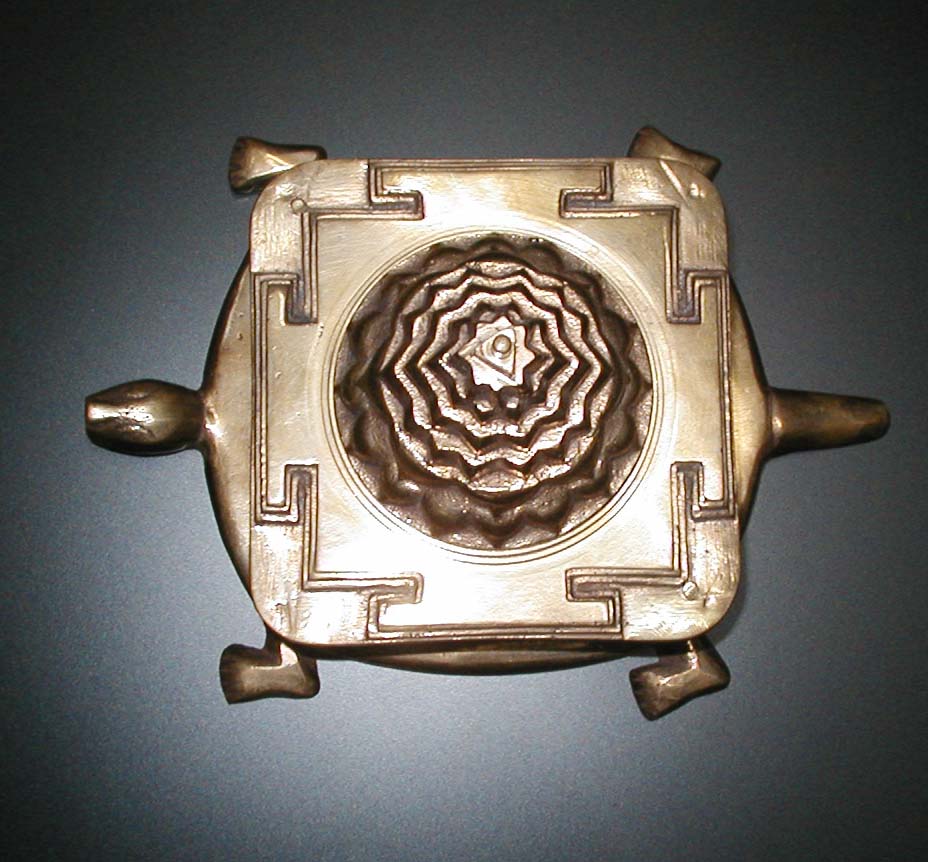
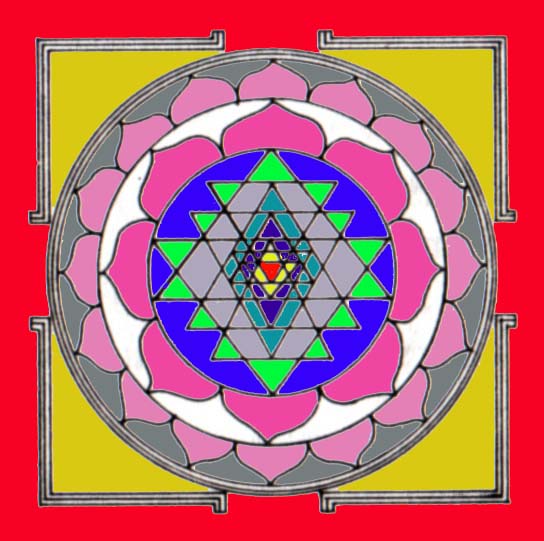
The Sri Yantra - or Yantra of Creation - is the most revered of all Hindu yantras. There is a mysterious beauty that arises in the way that 9 diverse triangles can inter link to form a state of perfect balance and harmony - creating 43 smaller triangles that comprise the Sri Yantra.
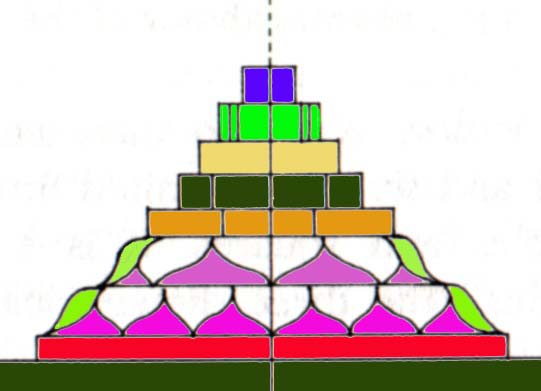
This very ancient symbol made an interesting appearance in modern times. It happened as a result of a series of experiments in the field of cymatics (the study of the interrelationship between energy and matter.) The sacred Hindu symbol "OM", when correctly intoned into the tonoscope (a devise that transforms sounds into their visual representations on a screen), produces a circle which is then filled in with concentric squares and triangles, finally producing, as the last traces of the 'M' disappear from the screen, the Sri Yantra.
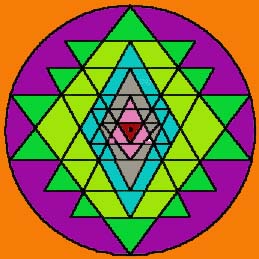
The sound vibration patterns which are generated by the many angles of the triangles of the SRI YANTRA were calculated by using the essential element of the circle around the triangular patterns, PI (3.1416) as the basic unit to which all the other ratios could relate. Therefore 3.1416 became a frequency vibration rate which, when doubled in value 6 times becomes 201.0624 cycles per second (or Hertz, ab. Hz) which is a sound tone equal on the international tuning scale of G+43 cents. Cents are divisions of micro tuning between notes on a piano keyboard. Each cent equals 1/100th division of sharp or flat between notes.
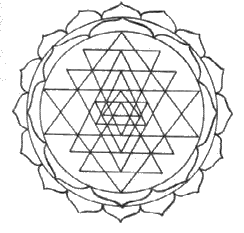
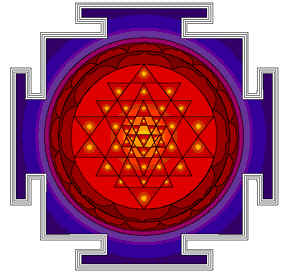
-
Both on side A and side B, I played the completed Sri Yantra through a series of thirteen different octaves (each octave being exactly twice or half of the frequency before or after it). This would correspond to Sri Yantras of different colors (each sound frequency has a color frequency correspondence separated by 40 octaves) and also to different sizes of Sri Yantras - extremely small with a high pitch and extremely large with a deep pitch. This approach makes these sound tracks a powerful tool for reaching deeper states of consciousness. Enjoy! Sincerely, - Dr Jeffrey Thompson.
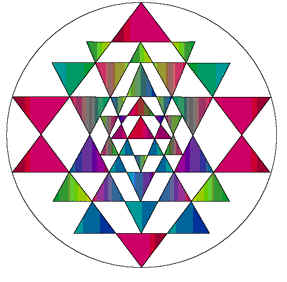
"I just purchased Sri Yantra and it is profound. I am a long time meditator in the tradition of Vedanta and I can hardly believe what you have accomplished, as these are truly the sounds I hear in my deepest reveries." Sam B., Portland

Sphatic Sriyantra is the Most effective tools for peace and prosperity, one can put at temple and cash box, at home and office or working area. Mercury and Sphatic are purest form of nature so, for both, installation pooja is not required.
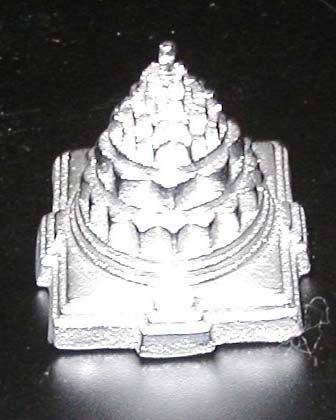
This is a Mercury Sriyantra.
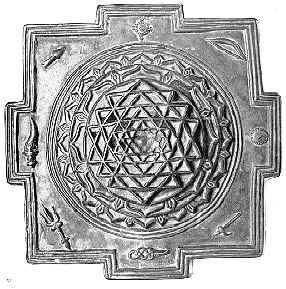

Rawson Lingam, engraved with Sri Yantra, probably used as initation
instrument for female Tantrikas, and for mediatation as symbol of
the emergence of creation, symbolized by the incised Sri Yantra from
the undifferentiated Ground of Being. Ranasthan, 17th century. Rock crystal h. 3 in.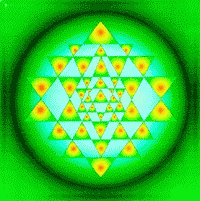

-
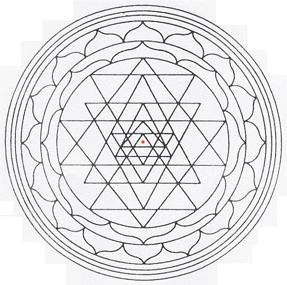
It is an ancient Indian design. It is called a "Sriyantra". It consists of
one red dot in the center and nine isoceles (2 of the three sides are of the same length)
triangles.
Can you count the overlapping triangles? Is there a good method to
make sure you don't overcount them. 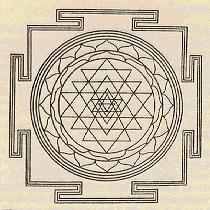

THE 15 SYLLABLE MANTRA
ka e i la hrim: ha sa ka ha la hrim: sa ka la hrim.
(These 15 letters are conceived to exist within the meru or spine of
a human being, from the base to the top of the head.)
- Literal Meaning : The syllables represent Shiva and Shakti. The first part, Ka E I La hrim, is called Vagbhava, and is Vama Shakti, Brahma, Jnana Shakti, and Eastern Face. The second part, Ha Sa Ka Ha La hrim, is Kamaraja, Jyesta Shakti, Vishnu, Iceha Shakti, and Southern Face. The third part, Sa Ka La hrim, is called Shakti, is Raudri Shakti, Rudra, Kriya Shakti and Western Face. The fourth part, the hidden or secret syllable, is mother goddess, Shambhu Natha, the totality of the three shaktis of Knowledge, Will and Action, and the Northern Face or amnaya.
- Traditional Meaning: Ka = air, Ha = fire, Sa = water, La = earth, Ha = aether. The vowels are above aether. The 15 syllables are 1 of aether, 2 of air, three of fire, four of water, and five of earth. The three forms of La represent the three Worlds. The five forms of the letter Ha represent sound.
- Inner Meaning: The vidya shows oneness of Shiva, Guru, devi and disciple; as it is Shiva in sound form (Shakti) which preserves the line.
Sri Yantra = Ragas by Mookerjee
From the permutations of Sri Yantra and the pentagon, especially in their primary relations to circle and square, we can derive the actual proportional series that govern the relationship of the notes with the musical scales (ragas and raginis) and the derivation of the secondary raginis from the primary ragas. This is the secret of Sri Yantra with its corresponding mantras.
Yantra and the musical modes of the raga system are inherently related through their mathematically-proportioned foundation. Just as the basic notes of each raga are harmonised so are the visible lines in each yantra. And just as the musical string must be plucked in a particular fashion to sound a certain note, so must the yantra line be mastered and mentally plucked to bring forth its image or power. Thus, the yantra diagram of apparently static lines will, with mental application, vibrate in perfect relation like a finely tuned musical instrument.
This is an ancient symbol from the Hindu tradition called the yantra of creation. A yantra
is a visual representation of resonant sound frequencies, used as a tool for developing a state
of attunement between individual consciousness and universal consciousness.
It has only recently been found that the sacred Hindu syllable "OM," when correctly
intoned into a modern device called a tonoscope (a machine that transforms sounds into their
visual representations on a computer screen), produces a circle which is then filled with
concentric squares and triangles, finally producing, when the last traces of the "m"
have disappeared, an image of the Sri Yantra.
They are many ways to look at what a symbol means. The experience of the very own flesh that is breathing and typing at this very moment is often mistaken for reality, it may as well be no more than a symbol. Where reality and symbols connect most certainly stands a greater reality than where they don't... And it is my belief/experience that the Sri Yantra is a doorway to such a reality. Of course this reflects only my opinion...
- Antoine Carré
Mookerjee, Sri Yantra. Copper plate. South India. 17th-18th century A.D. Sri Yantra repeats the form of the double triangle enclosed in a lotus within four walls. It is the symbol of Devi in two forms. Her own form (svarupa) and the form of the universe (visvarupa). This yantra is composed of two sets of triangles and chakras, on within the other, centered upton the bindu. The four triangles with points upwards represent the Siva element, and the five pointing downwards, the Sakti element. All are formed by the mula-prakriti (root-sakti) and the vikritas (manifestations) which, because of their creative power, are Prakriti. The nine chakras also represent sristi (creation), sthiti (maintenance) and samhara (dissolution), each set of three being formed by combinations. The ultimate object of meditation on this yantra is to realize the unit of jivatman (the meditator's individual soul) with the Devi. Practice of ritual transforms the minditself, and what at first semms merely as external yantra, with lines, corners and petals, becomes a pure mental state in the sadhaka himself. He, too, is a Sri Yantra, and he realizes himself as such. Private collection.
Further Explaination
1. THE EARTH SQ. OR BHUPURA- TRAI-LOKYA-MOHANA. A FORM OF THE TRIPLE DEVI KNOWN AS TRIPURI RULES ALL THESE SHAKTIS Am Aam Sauhoo
2. SIXTEEN PETALS- SARVA-SAPARI-PURAKA. The Shaktis in this circle are "Hidden Ones". This are called "fulfiller of Desires" Ayeim Kleem Sauhoo
3. EIGHT PETALS- SARVA-SANK-SOBHANA "ALL EXCITING CHAKRA" Presiding here is Tripura Sundari Hreem Kleem Sauhoo
4. FOURTEEN TRIANGLES- SARVASAU-BHAGYA-DAYAKA THE CHAKRA BESTOWING "ALL GOOD FORTUNE" Haim HKaleem - HSAUHOO
5. OUTER 10 TRIANGLES-SAVA-RTHA-SADHAKA THE CHAKRA BESTOWING "ALL OBJECTS TO THE SADHAKA" HsAIM HsKLEEM HsSOWHOO sSOWHOO HsAIM HsKLEEM HsSOWHOO
6. INNER 10 TRIANGLES- SARVA-RAKSA-KARA "THE CHAKRA PROTECING ALL". Hreem Kleem Bleem
7. EIGHT TRIANGLES-SARVA-ROGA-HARA "THE CHAKRA DESTROYING ALL DISEASE" Hreem Shreem Sauhoo.
8. CENTRAL TRIANGLE-SARVA-SIDDHI-PRADA. THE CHAKRA GIVING ALL SUCCESS LALITA DWELLS HERE AS "TRIPURA AMIKBA" Hreem Shreem Hsrauhoo
9. BINDU-SARV-ANANDA-MAYA. "PURELY BLISSFUL" SHODASHI MAHA MANTRA HER VIDYA (KAMARAJA VIDYA) Hreem Ka, Aye, Ei La Hreem Ha Sa Ka Ha La Hreem Sa Ka La Hreem
10. BALA SUNDARI- BHAIRAVI. HERE SHE IS WORSHIPPED AS BALA, AS A 16 YEARS OLD Ayeim Kleem Sauhoo
11. Gayatari Mantra: Tripurasundaryai Vidmahe Kameshvaryai Dheemahi Thannah Kleem Prachodayat
Meaning of Letters in Sri Yantra
1. The letter "la" denotes the earth- indicating in the SriChakra, The earth- stretch – BHUPURA, the boundary of 3 lines with Portals.
2. The letter "Sa" denoting the moon represents his 16 kalas –corresponding to the 16 patella Lotus in the Sri Chakra.
3. The letter "Ha" represents Siva, Ashtamurti, denotes the Eight patella Lotus in the Sri Chakra.
4. The letter "EI" is Maya, the sovereign of the worlds, Bhuvaneshwari, who encompasses in her sweep the higher Seven And lower Seven worlds and thus denoting Caturdasa kona in the Sri Chakra.
5. The letter "Aye" is for Shakti, the force of the protector Vishnu. Whose 10 Avatar make the Shakti tenfold as the outer dasara Chakra.
6. The letter "ra" is Fire with his famous Ten kalas, which makes the inner Dasara Chakra.
7. The letter "ka" Madana, which is Kameshwara, which has Eight forms Asta-murti which represents themselves as the Asta-Kona
8. The Ardha Candra by its very form resembles the primary triangle, while the letter Bindu goes to form the Bindu Sthana of the Sri Chakra. Thus, Sri Chakra is the product of the letters of Sri Vidya Mantra
20 Important Spiritual Instructions by Sri Swami Sivanand
These twenty instructions contain the very essence of all Yoga Sadhana, Karma, Bhakti, Jnana and Yoga will all come to one who follows them whole-heartedly. They are the unfailing keys to quick and effective development and culture of the physical, mental, moral and spiritual self of man.
1. BRAHMAMUHURTA : Get up at 4 a.m. daily. This is Brahmamuhurta which is extremely favorable for Sadhana. Do all your morning spiritual Sadhana during this period from 4 a.m. to 6:30 or 7 a.m. Such Sadhana gives quick and maximum progress.
2. ASANA : Sit on Padmasana (lotus pose), Siddhasana (adept's pose) or Sukhasana (any pose you like) for your JAPA and a meditation for half an hour, facing east or north. Increase the period gradually to three hours. Practice Sirshasana (head stand) and Sarvangasana (shoulder stand) for maintenance of health and Brahmacharya. Take light physical exercises as walking, etc., regularly. Do twenty rounds of easy, comfortable Pranayama (breathing exercises). Do not strain yourself while doing Pranayama.
3. JAPA : You can repeat any Mantra (sacred syllable), such as pure Om or Om Namo Narayanaya, Sri Ram, Sita Ram, Sri Ram Jaya Ram Jaya Jaya Ram, Om Namah Sivaya, Om Namo Bhagavate Vasudevaya, Om Saravanabhavaya Namah, Hari Om, or Gayatri (a sacred Vedic Mantra), according to your taste or inclination, from 108 times to 21,600 times daily. Devotees of Christ may repeat the name Jesus or Hail Mary, Mother of Jesus. Parsis, Sikhs and Muslims may select a name or Mantra from the Zend Avesta, Granth Sahib or Koran respectively.
4. DIETETIC DISCIPLINE : Take Sattvic food. Give up chilies, tamarind, garlic, onion, sour articles, oil, mustard, asafetida. Observe moderation in diet (Mitahara). Do not overload the stomach. Give up those things which the mind likes best for a fortnight once or twice in a year. Eat simple simple food. Milk and fruits help concentration. Take food as medicine to keep the life going. Eating for enjoyment is a sin. Give up salt and sugar for a week or a fortnight. You must be able to live on rice, dhal and bread without any pickle. Do not ask for extra salt for dhal, and sugar for tea, coffee and milk. People taking non-vegetarian diet should try their best to gradually give up flesh-eating as completely as possible. They will be immensely benefited.
5. Meditation : Have a separate meditation room under lock and key. If this is not possible then a corner of the room should be set apart with a small cloth screen or curtain drawn across. Keep the room spotlessly clean.
6. SVADHYAYA : Study systematically the Gita, Ramayana, Bhagavat, Vishnu-Sahasranam, Lalita-Sahasranama, Adityahridaya, Upanishads, Yoga Vasishta, Bible, Imitation of Christ, Zend Avesta, Quran, the Tripitakas, the Granth Sahib and other religious books from half an hour to one hour daily, and have Suddha Vichara (pure thoughts).
7. ELEVATE THE MIND : Get by heart some prayer - Slokas (prayer verses), Stotras (hymns) and repeat them as soon as you sit in the Asana before starting Japa or meditation. This will elevate the mind quickly.
8. BRAHMACHARYA : Preserve the vital force (Veerya (seminal energy)) very, very carefully. Veerya is God in motion or manifestation (Vibhuti). Veerya is all power. Veerya is all money. Veerya is the essence of life, thought and intelligence. This instruction is not for bachelors only. Householders also must follow it as far as possible. They must be extremely moderate in their marital connections with their spouse. This is very important.
9. CHARITY : Do charity regularly, every month, or even daily according to your means. Never fail in this item. If necessary forego some personal wants but keep up this charity regularly.
10. HAVE SATSANG : Give up bad company, smoking, meat and alcoholic liquors entirely. Have constant Satsang (association with holy people). Do not develop any evil habits. Deliberately exert to develop positive virtuous qualities.
11. FAST : Fast on Ekadasi (11th day of the Hindu lunar fortnight) or live on milk and fruits only. Christians must fast on alternate Sundays, Muslims on alternate Fridays, and Parsis on a suitable day every fortnight.
12. JAPA MALA : Have a Japa Mala (rosary) around your neck or in your pocket or underneath your pillow at night. This will remind you of God. Twirl the beads during your leisure. You should repeat the Name at all times, whatever task you may be engaged in.
13. OBSERVE MOUNA : Observe Mouna (vow of silence) for a couple of hours daily. Do not make gestures and inarticulate noises during the period of silence.
14. DISCIPLINE OF SPEECH : Speak the truth at all cost. Speak a little. Speak sweetly. Always utter encouraging words. Never condemn, criticize or discourage. Do not raise your voice and shout at little children or subordinates.
15. BE CONTENT : Reduce your wants. If you have four shirts, reduce the number to three or two. Lead a happy, contented life. Avoid unnecessary worry. Be mentally detached. Have plain living and high thinking. Think of those who do not possess even one-tenth of what you have. Share with others.
16. PRACTICE LOVE : Never hurt anybody. Ahimsa Paramo Dharmah (Non-injury is the highest virtue). Control anger by love, Kshama (forgiveness) and Daya (compassion). Serve the sick and the poor with love and affection. This is service of God.
17. BE SELF RELIANT : Do not depend upon servants. Self-reliance is the highest of all virtues.
18. HAVE SELF-ANALYSIS : Think of the mistakes you have committed during the course of the day, just before retiring to bed (self-analysis). Keep a daily spiritual diary and self-correction register as Benjamin Franklin did. Maintain a daily routine and resolve-form. Do not brood over past mistakes.
19. DO YOUR DUTY : Remember that death is awaiting you at every moment. Never fail to fulfill your duties. Have pure conduct (Sadachara).
20. REMEMBER GOD : Think of God as soon as you wake up and just before you go to sleep, and at all other times whether engaged in any work or not. Repeat His Name always. Surrender yourself completely to God (Saranagati).
This is the essence of all spiritual Sadhana. It will lead you to liberation. All these spiritual canons must be rigidly observed. You must not give any leniency to the mind.
Shri Bala Sundari Shodashi – The Eternal Beauty
| Hreem | For good bpdy structure and good personality |
| KA | To attain the power of invincibility |
| AYE | For an alluring, beautiful and captivating body |
| EI | For enchanting everything - into subjugation |
| LA | For achieving distinction in all knowledge'S and poetry |
| HREEM | To become popular amongst women |
| HA | For a disease-free and youthful body |
| SA | For active and vigorous life |
| KA | For ability of enchanting anybody instantly |
| HA | Wealth, fame and comforts |
| LA | For attaining unparalleled fame |
| HREEM | For attaining unsurpassed honors in life |
| SA | The person remains youthful, virile and handsome |
| KA | For success in all sadhanas and siddhis |
| LA | To mould any person according to one's thoughts |
| HREEM | For attaining totality in all the artha in life |